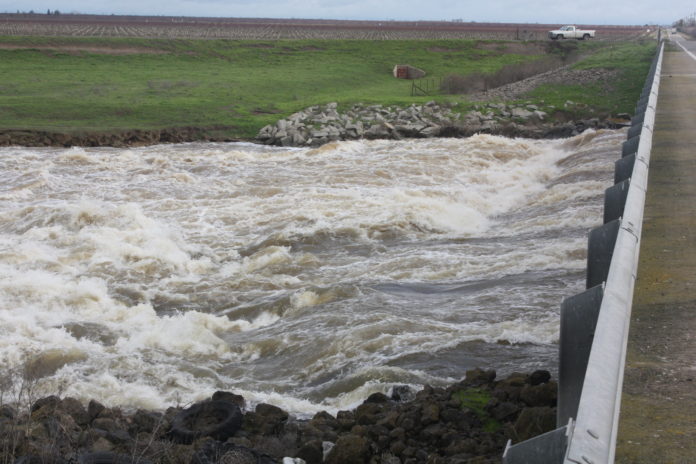The Water Blueprint for the San Joaquin Valley’s board met on Wednesday, March 15th at the International Agri-Center in Tulare followed by a public meeting. Both the board and the community meetings were online with Zoom. The organization’s website states, “The Water Blueprint for the San Joaquin Valley is a coalition of San Joaquin Valley community leaders, businesses, water agencies, local governments, and agricultural representatives working together to advance common sense water solutions for our region.”
The Blueprint’s Mission Statement is, “Unifying the San Joaquin Valley’s voice to advance an accessible, reliable solution for a balanced water future for all,” and its Vision Statement is, “The Water Blueprint serves as the united voice to champion water resource policies and projects to maximize accessible, affordable, and reliable supplies for sustainable and productive farms and ranches, healthy communities, and thriving ecosystems in the San Joaquin Valley.”
How often do you hear someone say something has to be done? That’s usually following a list of the problems defined. It’s true in order to solve a problem it needs to be identified. That is often the easy part. The follow up is developing a solution. There are many solutions for all manner of perceived problems. Solutions can range from simplistic to complex and ridiculous to feasible. The next step is the heavy lift. Implementing the solution.
For example: my clothes don’t fit, I’m tired all the time, when I got out of the shower the other day a naked fat man jumped between me and the mirror. The problem defined: I’m packing too many extra pounds. The solution: eat less, exercise more. The implementation: self-discipline. Ouch.
Another example: the San Joaquin Valley continues to have its surface water supplies reduced and we’re headed for an economic train wreck as we are forced to fallow productive farmland. The problem defined: we need more water. The solution: capture excess flood flows from the Delta. The implementation: The Water Blueprint for the San Joaquin Valley.
The Board Meeting
The Blueprint has often been called a coalition of the willing. As a nonprofit the Blueprint has a structural organization. There is an executive committee, a board of directors and three additional committees: technical, advocacy and communications. This meeting went like any other board meeting – approval of minutes, agenda and financial statements. It was announced the planned Delta/San Joaquin Valley summit has been postponed due to flooding.
The big news from the board meeting was the official announcement of the Hallmark Group being hired to help guide the organization and implement the plan. Chuck Gardner is the President and will be the point person. If that name is familiar to you it should be. Gardner has a tremendous amount of experience with water in California including working intimately on the Twin Tunnels project in the Delta. Gardner spoke to the board about transitioning Hallmark into the Blueprint. They’ll be looking at regulatory and water rights issues and evaluating and prioritizing feasible projects.
The Blueprint is still a fairly young organization and has been making good progress. Bringing the experience of Gardner and the Hallmark Group to bear on achieving the desired goals is another step forward.
The Public Meeting
In my experience, and I have been going to meetings for a while, the younger the organization the easier it is to start and stop on time. I guess there’s just less accumulated baggage to haul around. The Public/Large Group meeting started right on time at the advertised 2:00pm. This was an informational meeting for the world and no votes were taken. There were three online speakers and two presentations by Blueprint committee members.
Senator Melissa Hurtado
State Senator Melissa Hurtado spoke first saying water security is global and not just a San Joaquin Valley problem. She said at least 10 countries have about a decade before becoming extremely vulnerable due to water shortages. (I’ve heard northeast China in the Peking, or Beijing as some like to call it, area is in big trouble water-wise.)
Hurtado cited the funding for the Friant Kern Canal repairs as a good start for California to begin shoring up its outdated infrastructure. She made a common sense statement that California should be its own food source and should elevate agricultural as a beneficial part of the state’s economy. She would like to see more involvement with local supporters.
Ian LeMay, Board Chairman of the Blueprint asked Hurtado about working with the State Water Resources Control Board. Hurtado said the Natural Resources Oversight Committee will be taking a close look at how the State Board conducts business and spends tax-dollars.
Mike Wade, Chair of the Blueprint’s Communication Committee said 38 percent of the fresh fruit and vegetables consumed in California are imported. He wanted to know if the state can do anything to promote locally sourced food. Hurtado said this is a matter of national security and she plans to have hearings on the matter this year.
LeMay thanked Hurtado for her work to help increase water supplies and update infrastructure in the San Joaquin Valley.
Senator Anna Caballero
State Senator Anna Caballero wasn’t able to address the gathering but had her Senior Policy Analyst Michele Canales speak online. Unfortunately the senator’s message was left vague due to some presentation difficulties. Ms. Canales wore a mask and her voice was muffled. Perhaps she explained why she was wearing a mask to make a Zoom call but I didn’t hear her do so. There were some comments on how distracting it was. And, to be sure wearing a mask on a Zoom call was off putting but not as off putting as Frank – whoever he was. There was a man’s voice in the background providing a constant running narrative for his half of a phone call that further defeated any hope of understanding what Canales was trying to say. Of course everyone thought someone on the Zoom call wasn’t muting but after going through all the participants that wasn’t the case. The extra voice was coming from Caballero’s office. I think I might have heard Caballero is introducing a bill but what its number or purpose is I don’t know. I might have heard Caballero is a supporter of the Blueprint. I hope so. All in all, not a good example of communicating.
Ellen Hanak
The last invited guest was Ellen Hanak of the Public Policy Institute of California. To my mind the Blueprint owes a certain debt to Ms. Hanak. The PPIC think tank’s study of the negative impact of the Sustainable Groundwater Management Act on the San Joaquin Valley’s economy was the spark that began the serious work of mitigation being done by the Blueprint. I first heard her presentation several years ago in Bakersfield when she shared the data PPIC compiled.
Hanak spoke about a recent PPIC report titled, “The Future of Ag in the San Joaquin Valley,” which didn’t paint a pretty picture. She said there is the potential of having to fallow 500,000 acres of irrigated farmland and the Valley needs to prepare for a 20-percent reduction in water supply by 2040. This will lead to 50,000 jobs lost. By 2040 possible climate changes and environmental regulations could cause a $1.5 billion loss annually to the local economy. She said surface and groundwater trading could help soften the blow and maybe only set things back $800 million per year in losses. The best bet is to increase productivity.
climate changes and environmental regulations could cause a $1.5 billion loss annually to the local economy. She said surface and groundwater trading could help soften the blow and maybe only set things back $800 million per year in losses. The best bet is to increase productivity.
An online man asked what would happen if SGMA was never enacted. Hanak said that would be difficult to guess but it wouldn’t go well for the Valley to have its groundwater all pumped out.
LeMay asked how this report was received in Sacramento and Hanak replied the agencies at least now recognize the need for recharge and the Governor’s recent executive order has helped to further that.
Congressional Opinion
Congressman Jim Costa showed up in person and made a statement. He said he disagrees with Hanak and PPIC on some of the figures in the report. He said the negative economic impact could be closer to $7 billion per year. He said the state’s water system is broken and food is a national security issue.
Costa agreed the Valley needs a new plan that will increase water supplies and the Blueprint is a good vehicle to lead this effort. There is new federal money in existing and proposed legislation that could go to projects like the Friant Kern Canal and raising the dam at San Luis Reservoir. He acknowledged repurposing land, even in white areas, is a sensitive issue.
Costa ended by saying, “The Water Blueprint is essential and I will do everything I can to work with you.”
Committee and Other Reports
There was a brief introduction of Gardner and Jessica Alwan of the Hallmark Group. There is what could be called a sister group to the Blueprint effort known as the Cooperative Action Plan. CAP has been led by Tim Quinn, former head of Metropolitan Water District of Los Angeles and more recently a fellow at Stanford University. CAP is a gathering of various interests into caucuses such as: environmental, drinking water, agriculture and local governance. They gather in silos and have been finding the common ground on defining the problem and putting forth solutions.
governance. They gather in silos and have been finding the common ground on defining the problem and putting forth solutions.
Laura Ramos, Associate Director of Research & Education at the California Water Institute reported CAP received $995,000 from the US Bureau of Reclamation to further its efforts and of course the California Water Institute has been contributing in-kind.
Ramos reported Phase I of the CAP has been completed and a framework has been agreed upon by 70 participants from all the diverse interests. Phase II focusing on implementation of strategy has begun. Quinn has moved from the Chair of the CAP to the Steering Committee and Ann Hayden of the Environmental Defense Fund and Sarah Woolf of Water Wise are the new Co-Chairs. The goal is to bring about a unified water plan for the San Joaquin Valley with help from the Bureau, CWI and the Blueprint.
Technical Committee
Committee Chair Dr. Scott Hamilton started his report by saying words come cheap in Sacramento. This is true as the vast majority of legislators come from dense urban areas and seem dedicated to extending the power of the state. The goal is to limit access to water instead of creating solutions to provide more access. As Hamilton said meeting needs and demands is a lost strategy to much of Assembly and State Senate as well as the massive bureaucracy attached to the Governors’ office.
Hamilton pointed out a huge opportunity was lost this year from a lack of preparation by the state to implement recharge and repair and upgrading of old, antiquated facilities. He said the PPIC report is pushing an agenda of more trading but that won’t fix the fundamental problem. Trading and fallowing are not the first response to this problem. He said the Blueprint prioritizes projects. There are 10 offered and feedback is welcome. He had a chart showing the projects. This will all be passed on to Gardner to help with evaluating feasibility and an implementation plan.
Hamilton has worked on Delta matters for decades and said the Delta has become a black hole for money and sound science. The fish screens at the state and federal pumps are more than 50-years old and no longer serve the increased demands. The Blueprint is proposing an Environmentally Friendly Water Diversion. It is a way to move water from the Delta during flood flows without any harm to fish and other aquatic organisms. There is a $5 million pilot project ready to go as soon as funding is secured.
The entire Blueprint hinges on being able to take a portion of water from the short seasonal flood flows through the Delta and conveying it to the San Joaquin Valley for recharge. This happens when there are flows far above all the environmental, salinity and other regulatory requirements and will not harm any aquatic species flora or fauna.
Interim Chief Executive Officer Austin Ewell thanked everyone for their attendance and the speakers for their time. The public meeting adjourned on time at 3:30pm.
DISCLAIMER OF RESPONSIBILITY; Waterwrights.net strives to provide its clients with the most complete, up-to-date, and accurate information available. Nevertheless, Waterwrights.net does not serve as a guarantor of the accuracy or completeness of the information provided, and specifically disclaims any and all responsibility for information that is not accurate, up-to-date, or complete. Waterwrights.net’s clients therefore rely on the accuracy, completeness and timeliness of information from Waterwrights.net entirely at their own risk. The opinions expressed in this report are those of the author and do not represent any advertisers or third parties.
ALL RIGHTS RESERVED. Copyright 2023 by WaterWrights.net

































